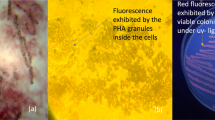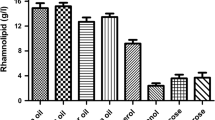Abstract
The extensive use of synthetic plastics has caused serious waste disposal problems in our environment. Poly-3-hydroxybutyrates (PHB) are eco-friendly bacterial polyesters which are produced under unbalanced nutrient conditions. Few reports are available on PHB production by solid state fermentation (SSF). We have developed a novel SSF bioprocess in which polyurethane foam (PUF) is used as a physical inert support for the production of PHB by Bacillus sphaericus NII 0838. Media engineering for optimal PHB production was carried out using response surface methodology (RSM) adopting a Box–Behnken design. The factors optimized by RSM were inoculum size, pH and (NH4)2SO4 concentration. Under optimized conditions—6.5 % inoculum size, 1.7 % (w/v) (NH4)2SO4 and pH 9.0—PHB production and biomass were 0.169 ± 0.03 and 0.4 ± 0.002 g/g PUF, respectively. This is the first report on PHB production by SSF using PUF as an inert support. Our results demonstrate that SSF can be used as an alternative strategy for the production of PHB.







Similar content being viewed by others
References
Aidoo KE, Hendry R, Wood BJB (1982) Solid substrate fermentations. Adv Appl Microbiol 28:201–237
Bobbio FO, El-Dash AA, Bobbio PA, Rodrigues LR (1978) Isolation and characterization of the physicochemical properties of the starch of jackfruit seeds (Artocarpus heterorphyllus). Cereal Chem 55:505–511
Box GEP, Behnken DW (1960) Some new three level designs for the study of quantitative variables. Technometrics 2:455–475
Byrom D (1987) Polymer synthesis by microorganisms: technology and economics. Trends Biotechnol 5:246–250
Byrom D (1994) Polyhydroxyalkanoates. In: Mobley DP (ed) Plastics from microbes: microbial synthesis of polymers and polymer precursors. Hanser, Munich, pp 5–33
Chi Z, Zhao S (2003) Optimization of medium and cultivation conditions for pullulan production by new pullulan-producing yeast. Enzyme Microb Technol 33:206–221
Choi J, Lee SY (1997) Process analysis and economic evaluation for Poly (3-hydroxybutyrate) production by fermentation. Bioproc Eng 17:335–342
Gervais P, Molin P (2003) The role of water in solid-state fermentation. Biochem Eng J 13:85–101
Grothe E, Moo-Young M, Chisti Y (1999) Fermentation optimization for the production of poly (β-hydroxybutyric acid) microbial thermoplastic. Enzyme Microb Technol 25:132–141
Henika RG (1972) Simple and effective system for use with response surface methodology. Cereal Sci Today 17:309–334
Joglekar AM, May AT (1987) Product excellence through design of experiments. Cereal Foods World 32:857–858
John RP, Nampoothiri KM, Pandey A (2006) Solid-state fermentation for l-lactic acid production from agrowaste using Lactobacillus delbrueckii. Process Biochem 41:759–763
Kominek LA, Halvorson HO (1965) Metabolism of poly-β-hydroxybutyrate and acetoin in Bacillus cereus. J Bacteriol 90:1251–1259
Lakshman K, Rastogi NK, Shamala TR (2004) Simultaneous comparative assessment of parent and mutant strain of Rhizobium meliloti for nutrient limitation and enhanced polyhydroxyalkanoate (PHA) production using optimization studies. Process Biochem 39:1977–1983
Law JH, Slepecky RA (1961) Assay of poly-β-hydroxybutyric acid. J Bacteriol 82:33–36
Miller GM (1959) Use of dinitrosalicylic acid reagent for determination of reducing sugar. Anal Chem 31:426–428
Oliveira FC, Freire DMG, Castilho LR (2004) Production of poly (3-hydroxybutyrate) by solid-state fermentation with Ralstonia eutropha. Biotechnol Lett 26:1851–1855
Oliveira FC, Dias ML, Leda R, Castilho LR, Freire DMG (2007) Characterization of poly (3-hydroxybutyrate) produced by Cupriavidus necator in solid-state fermentation. Bioresour Technol 98:633–638
Ramadas NV, Singh SK, Soccol CR, Pandey A (2009) Polyhydroxybutyrate production using agro-industrial residue as substrate by Bacillus sphaericus NCIM 5149. Braz Arch Biol Technol 52:17–23
Ramadas NV, Soccol CR, Pandey A (2010) A statistical approach for optimization of polyhydroxybutyrate production by Bacillus sphaericus NCIM 5149 under submerged fermentation using central composite design. Appl Biochem Biotechnol 162:996–1007
Ramesh MV, Lonsane BK (1990) Critical importance of moisture content of the medium in alpha amylase production by Bacillus licheniformis M27 in a solid state fermentation medium. Appl Microbiol Biotechnol 33:501–505
Sandhya X, Lonsane BK (1994) Factors influencing fungal degradation of total soluble carbohydrates in sugar cane pressmud under solid state fermentation. Proc Biochem 29:295–301
Sindhu R, Ammu B, Binod P, Deepthi SK, Ramachandran KB, Soccol CR, Pandey A (2011) Production and characterization of poly-3-hydroxybutyrate from crude glycerol by Bacillus sphaericus NII 0838 and improving its thermal properties by blending with other polymers. Braz Arch Biol Technol 54:783–794
Steinbuchel A (1991) Polyhydroxyalkanoic acids. In: Byrom D (ed) Biomaterials: novel materials from biological sources. Stockton, New York, pp 124–213
Tabandeh F, Farahani EV (2003) Biosynthesis of poly-β-hydroxybutyrate as a biodegradable polymer. Iran Polym J 12:37–42
Yuksekdag ZN, Aslim B, Beyatli Y, Mercan N (2004) Effect of carbon and nitrogen sources and incubation times on poly-β-hydroxybutyrate (PHB) synthesis by Bacillus subtilis 25 and Bacillus megaterium. Afr J Biotechnol 3:63–66
Zhu Y, Smits JP, Knol WK, Bol J (1994) A novel solid-state fermentation system using polyurethane foamas inert carrier. Biotechnol Lett 16:643–648
Acknowledgments
One of the authors (NVR) gratefully acknowledges the Council of Scientific and Industrial Research (CSIR), New Delhi, India, for the award of Senior Research Fellowship during this course of investigation.
Author information
Authors and Affiliations
Corresponding author
Rights and permissions
About this article
Cite this article
Ramadas, N.V., Sindhu, R., Binod, P. et al. Development of a novel solid-state fermentation strategy for the production of poly-3-hydroxybutyrate using polyurethane foams by Bacillus sphaericus NII 0838. Ann Microbiol 63, 1265–1274 (2013). https://doi.org/10.1007/s13213-012-0584-7
Received:
Accepted:
Published:
Issue Date:
DOI: https://doi.org/10.1007/s13213-012-0584-7




